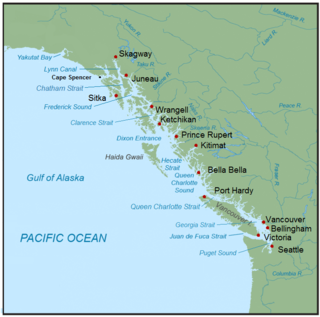
Southeast Alaska, colloquially referred to as the Alaska(n) Panhandle, is the southeastern portion of the U.S. state of Alaska, bordered to the east and north by the northern half of the Canadian province of British Columbia. The majority of Southeast Alaska's area is part of the Tongass National Forest, the United States' largest national forest. In many places, the international border runs along the crest of the Boundary Ranges of the Coast Mountains. The region is noted for its scenery and mild, rainy climate.

The Inside Passage is a coastal route for ships and boats along a network of passages which weave through the islands on the Pacific Northwest coast of the North American Fjordland. The route extends from southeastern Alaska in the United States, through western British Columbia in Canada, to northwestern Washington state in the United States. Ships using the route can avoid some of the bad weather in the open ocean and may visit some of the many isolated communities along the route. The Inside Passage is heavily travelled by cruise ships, freighters, tugs with tows, fishing craft, pleasure craft, and ships of the Alaska Marine Highway, BC Ferries, and Washington State Ferries systems. Coast Guard vessels of both Canada and the United States patrol and transit in the Passage.

The Chilkoot Trail is a 33-mile (53 km) trail through the Coast Mountains that leads from Dyea, Alaska, in the United States, to Bennett, British Columbia, in Canada. It was a major access route from the coast to Yukon goldfields in the late 1890s. The trail became obsolete in 1899 when a railway was built from Dyea's neighbor port Skagway along the parallel White Pass trail.

The Alaska Marine Highway (AMH) or the Alaska Marine Highway System (AMHS) is a ferry service operated by the U.S. state of Alaska. It has its headquarters in Ketchikan, Alaska.

Lynn Canal is an inlet into the mainland of southeast Alaska.
This article discusses transportation in the U.S. state of Alaska.

M/V Taku is a Malaspina-class mainline vessel built for the Alaska Marine Highway System. The ship has been retired and was sold to a Dubai-based company for $171,000. The owner sought to sell the ferry internationally, and was unsuccessful, and it was last seen beached in Alang, India, to be scrapped.

MV Aurora is a feeder vessel for the Alaska Marine Highway System, built in Sturgeon Bay, Wisconsin in 1977 by Peterson Shipbuilders and commissioned by the Alaska Marine Highway System the same year.

M/V Chenega is a catamaran ferry built by Derecktor Shipyards in Bridgeport, Connecticut for the Alaska Marine Highway System entering service 2005. After being laid up in 2017, in March 2021 it was sold by the Alaska Department of Transportation & Public Facilities to Servicios y Concesiones Maritimas Ibicencas along with sister ship MV Fairweather for service between Spain and Ibiza.

MV Fairweather is a catamaran ferry built by Derecktor Shipyards in Bridgeport, Connecticut for the Alaska Marine Highway System entering service 2004. After being laid up since 2019, in March 2021 it was sold to Servicios y Concesiones Maritimas Ibicencas for service between Mallorca and Menorca.

MV Matanuska, colloquially known as the Mat, is a mainline Malaspina-class ferry vessel operated by the Alaska Marine Highway System.

The M/V Columbia is a mainline ferry vessel for the Alaska Marine Highway System.

M/V Kennicott is a mainline ferry vessel for the Alaska Marine Highway System.

M/V Tustumena is a mainline ferry vessel for the Alaska Marine Highway System.

The Lynn Canal Highway, or Juneau Access Road, is a proposed road between Skagway and City and Borough of Juneau, the capital of the U.S. state of Alaska. Such a road, if built, would still require ferry access to connect Juneau to the Alaskan highway network. The new road would be 47.9 miles long, built at a cost of $574 million, and be a part of Alaska Route 7. The plan of the Alaska Department of Transportation & Public Facilities (DOT&PF) called for extending "The Road" northward from Juneau to a ferry terminal 18 miles south of Skagway. The corridor crosses Berners Bay LUD II which is a congressionally designated roadless area created by the Tongass Timber Reform Act (TTRA). The act permits crossing LUD IIs when the governor of the State of Alaska designates routes as essential transportation corridors. The proposed road skirts the shore of a northwestern section of Alaska's Inside Passage, which was recently named a National Scenic Waterway. As of 2017, the project has been indefinitely shelved due to the state's budget crisis.

MV Queen of Prince Rupert was a roll-on/roll-off (RORO) ferry operated by BC Ferries that provided the main surface transport link between the Queen Charlotte Islands and mainland British Columbia, connecting Skidegate with Prince Rupert across the Hecate Strait. The vessel also ran on the Prince Rupert–Port Hardy Inside Passage route during the low season.

The MV Wickersham was a mainline ferry vessel for the Alaska Marine Highway. Wickersham was the second vessel, after the MV Chilkat, in the Alaska Marine Highway fleet to not have been constructed specifically for AMHS, but was rather acquired for from the Stena Line, where it was known as the Stena Britannica and served the Kiel, Germany–Gothenburg, Sweden route. Constructed just one year prior to its purchase by AMHS in April 1968, her arrival and status as an "oceangoing" vessel allowed AMHS to expand the southern terminus of its route system south to Washington and the Port of Seattle.

MV Malaspina Sky is an Intermediate-class ferry in the BC Ferries fleet built in 2008.
The Alaska Department of Transportation & Public Facilities (DOT&PF) is a department within the government of Alaska. Its headquarters are in Alaska's capital city, Juneau. The mission of Alaska DOT&PF is to "Keep Alaska Moving through service and infrastructure."

MV Tazlina is a ferry operated by the Alaska Marine Highway System. It began serving Southeast Alaska Communities in 2019.



















